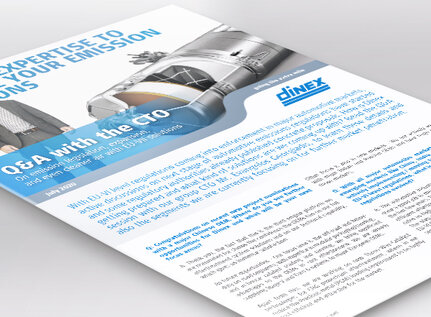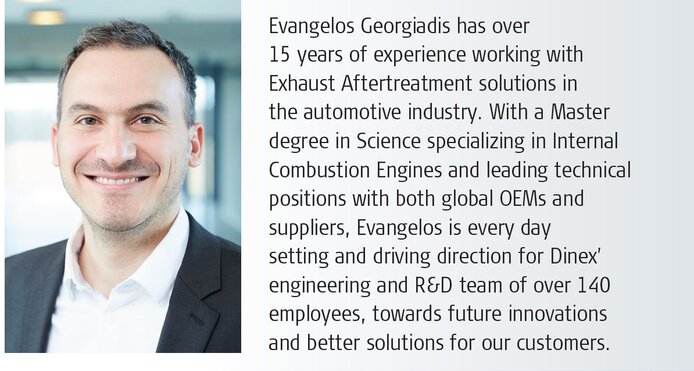- News and Events
- News
- Q&A with the CTO

With EU-VI level regulations coming into enforcement in major automotive markets, active discussions on next stage of automotive emissions regulations have started and some regulatory authorities already published concrete proposals. How is Dinex getting prepared and what kind of solutions are we coming up with? Read the Q&A session with our group CTO Mr. Evangelos Georgiadis, to learn these details and also the segments we are currently focusing on for further market penetration.
Q: Congratulations on recent new project nominations with a major Chinese OEM. Where do you see further opportunities for Dinex and what will be your next focus areas?
A: Thank you, the fact that this is the third engine platform we are nominated for shows the confidence the OEMs has on our full aftertreatment system solutions and on our technical capability, which gives us immense satisfaction.
As future opportunities - Our focus area is the off-road and heavyduty on-road segments, with expertise in modular packaging/canning, and in-house catalyst coating and canning, we bring significant advantages to the OEMs in cost effectiveness. We are already supplying Stage V and Euro 6 systems to major European OEMs.
Apart from this, we are working on new Three-Way-Catalyst technologies for CNG powertrain aftertreatment, where in we reduce the Precious metal (PGM) loading requirement to be highly cost efficient and attractive for the market.
Other focus is also in new markets - We are actively working with major Indian and Russian OEMs and have huge plans for those markets.
Q: With all major automotive markets (western and emerging markets like China, India, Russia and Brazil) actively implementing / moving towards implementing EU-VI level regulations, what is your opinion on how the regulations evolved?
A: The automotive industry and the regulatory authorities have done a good job in minimizing the emissions from IC engines over the last few years. The latest generation EU-VI engines have highly efficient aftertreatment systems, which could get NOx conversion rates as high as 98%-99% and PN filtration levels of up to 99.9%. The step wise implementation of the In-service-Conformity (ISC) EU-VI C to E regulations, has ensured to replicate the performance seen in test bed conditions on road, to a maximum extent.
Q: What is expected about EU-VII level regulations, how is the post EU-VI level scenario shaping up?
A: There have been concrete discussions and proposals on next level of emissions regulations. The main areas of focus in Diesel segment are further reduction of NOx limits, shifting of current particle (PN) size limit for regulatory consideration from 23 nm to 10 nm, limits for N2O and NO2 and reducing the NH3 limit levels. In the natural gas segment the same PN and N2O considerations are being made, as well as more tightened limits for CH4, NOx and NH3 emissions.
China and India are expected to follow the European path, and in the US CARB recently announced new Heavy Duty regulation proposals (NOx up to 20 mg/bhp, PM 5 mg/bhp, in two steps - in 2024 and then in 2027).
Discussions have been already taking place in Europe about tightening the afore mentioned species limits, unifying the emissions norms across all vehicle segments- Passenger cars and commercial vehicles and standardizing emissions measurements in g/km and finally remote monitoring and recording of actual emissions data are some of the topics that are actively being discussed.
Q: As a supplier in a highly competitive field, what differentiates Dinex from others and what you bring on to the table for OEMs?
A: Based on the market feedback, we definitely bring cost effectiveness on to the table through our Full system solution approach and high efficiency ATS solutions. Through this approach, we simplify the supply chain and also the development efforts from OEM side. Apart from this, we are intensively working on further enhancing our customer service by increasing the engineering workforce in the local markets.
Q: Is Dinex ready with solutions for the next level emissions regulations?
A: On the readiness for next level regulations – we already have developed suitable systems to meet the future regulations of both Diesel and Natural Gas applications. Our two-stage SCR systems are thoroughly tested and can reach NOx reduction levels of > 99% in regulatory and relevant tough duty cycles, achieving very low levels on other relevant species. Apart from this, through our thermal insulated piping solutions, we can ensure minimal temperature losses ensuring best conversion efficiencies. We are very confident that we are well prepared to support our customers with upcoming emissions regulations.


